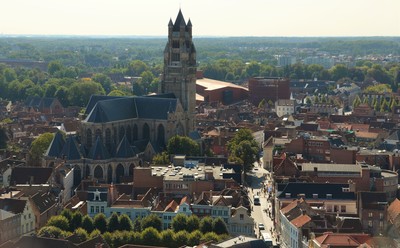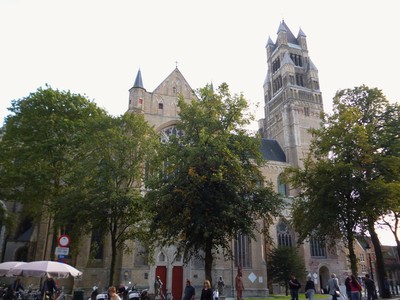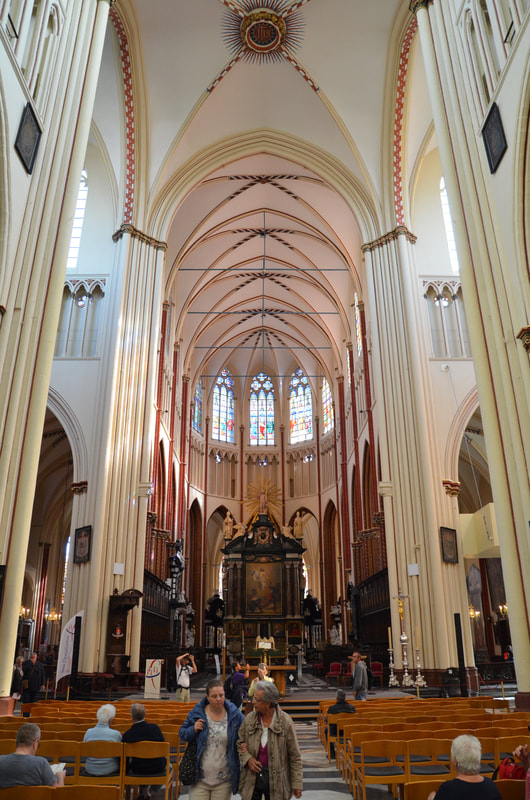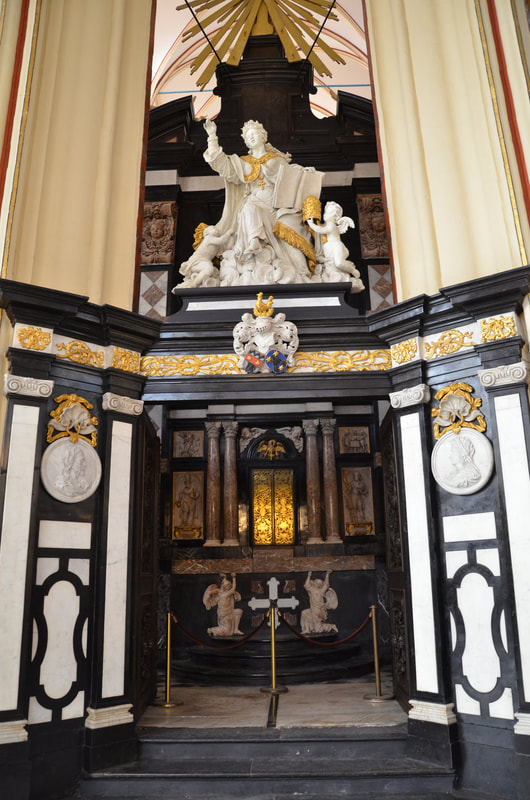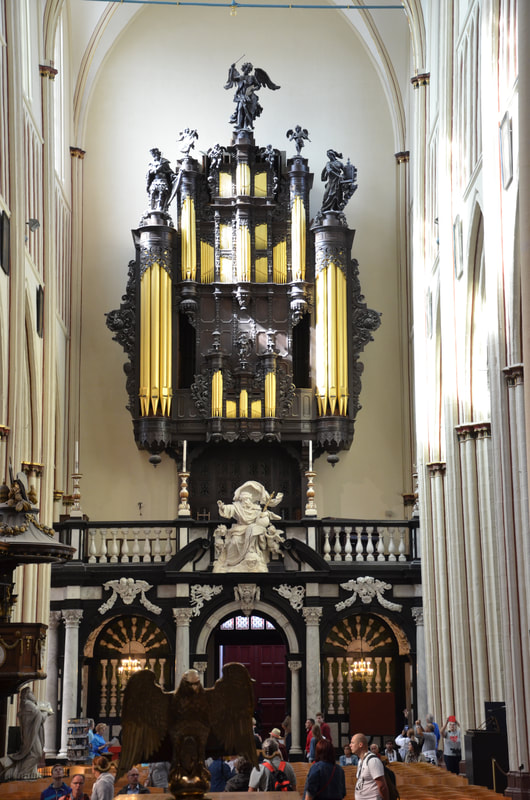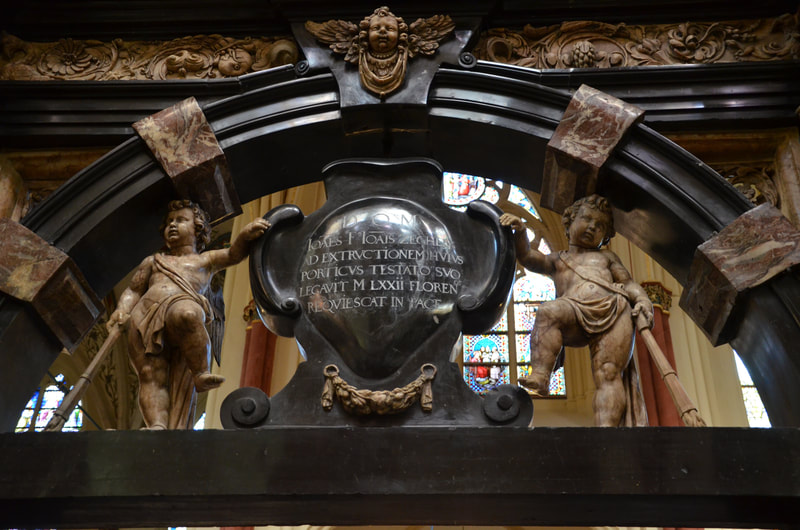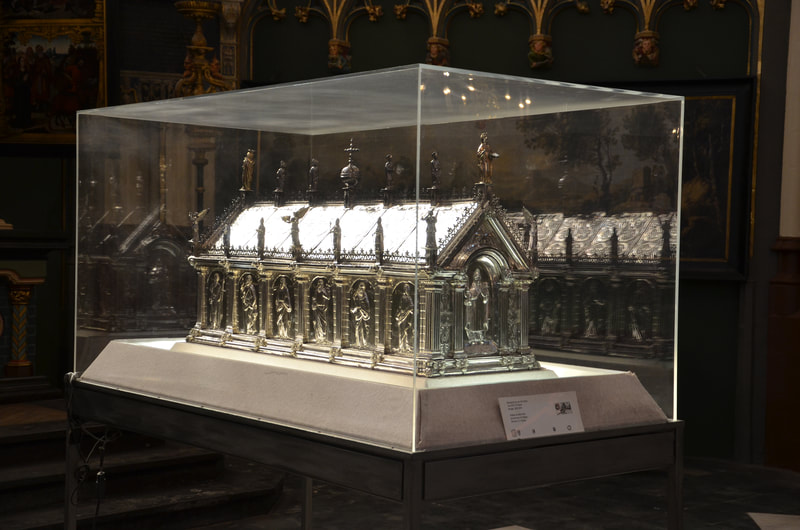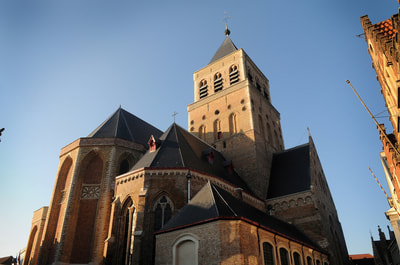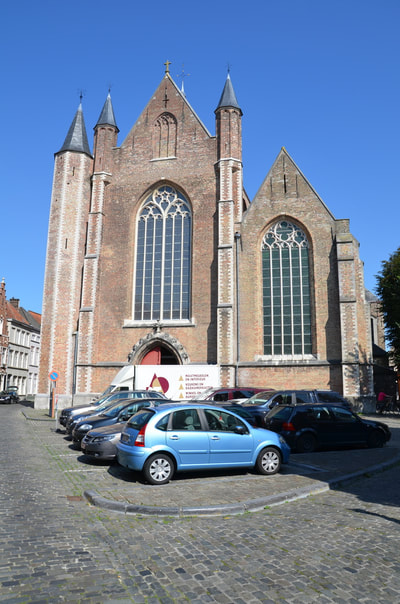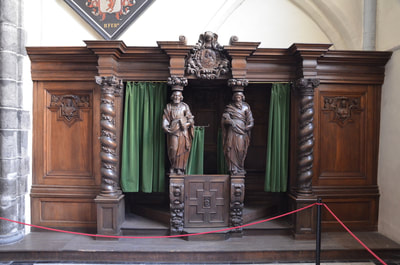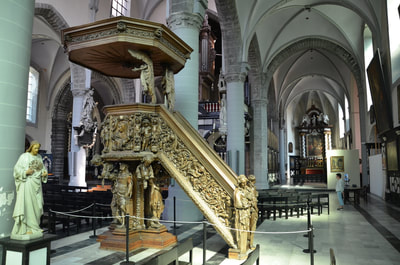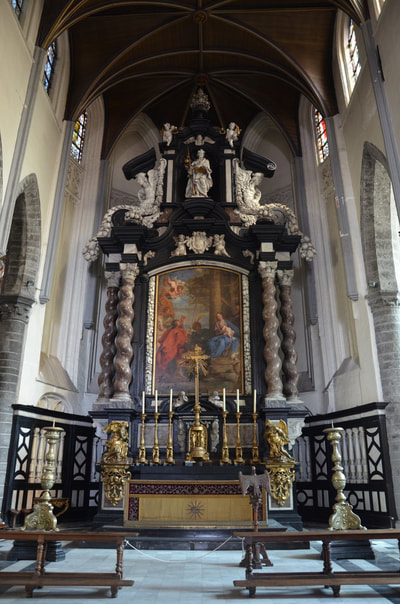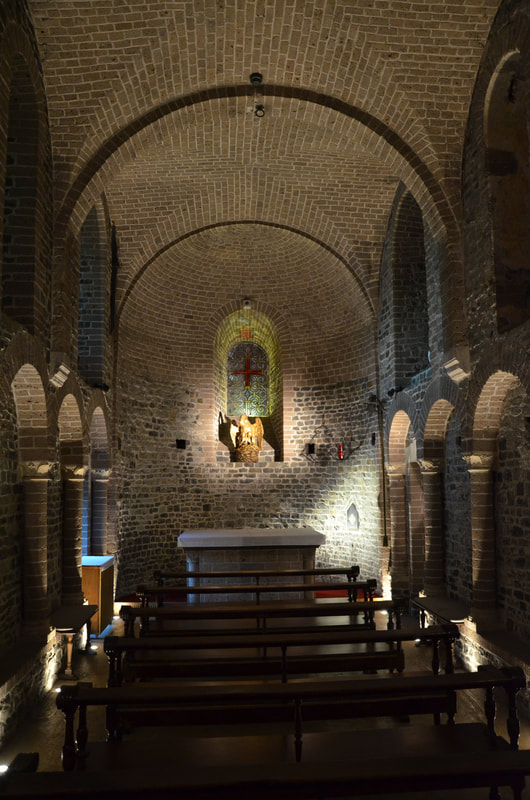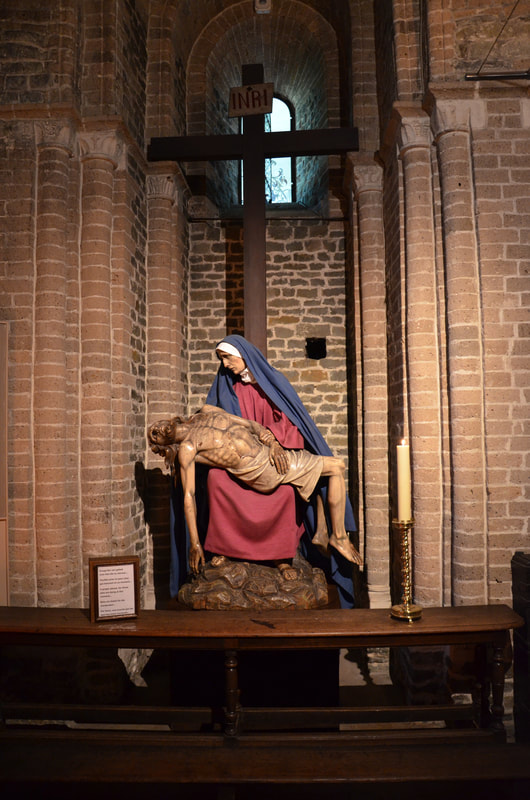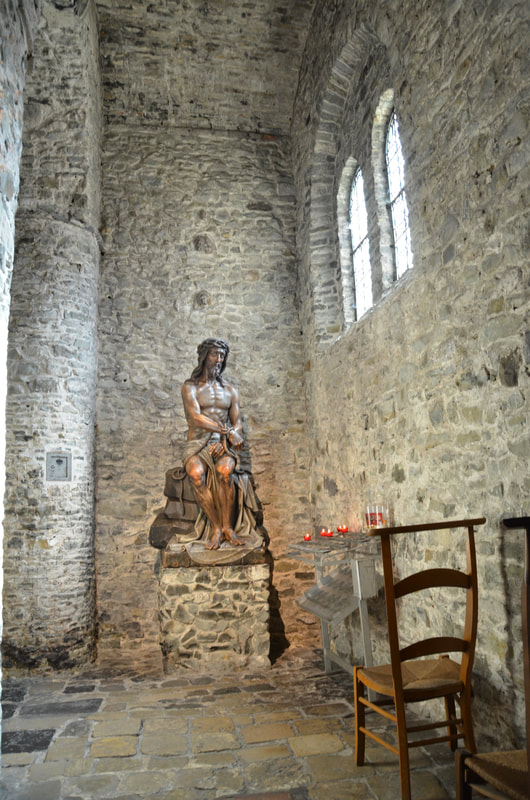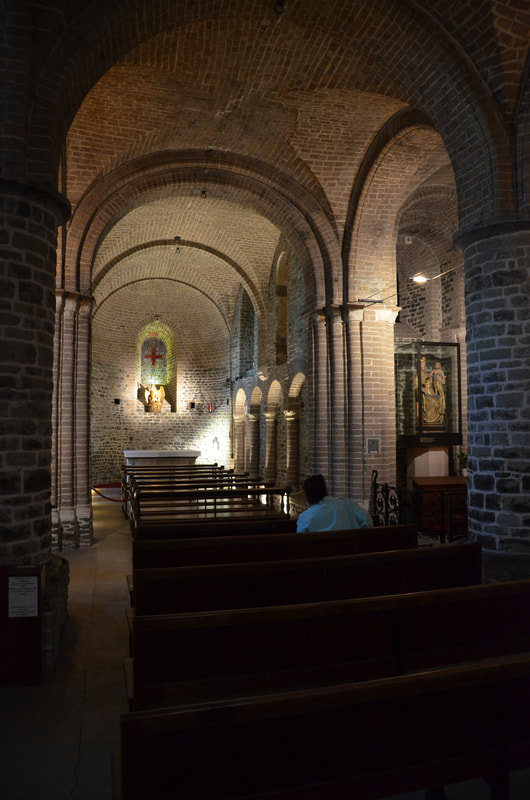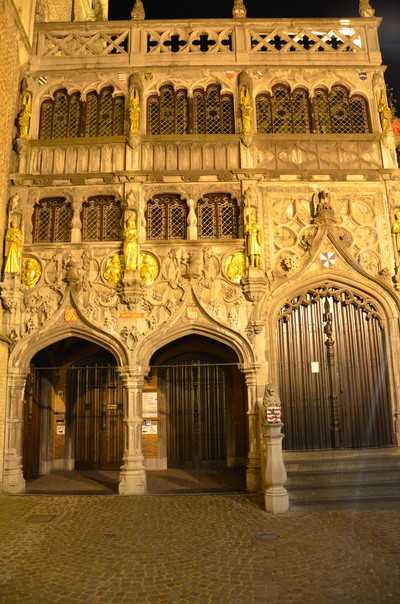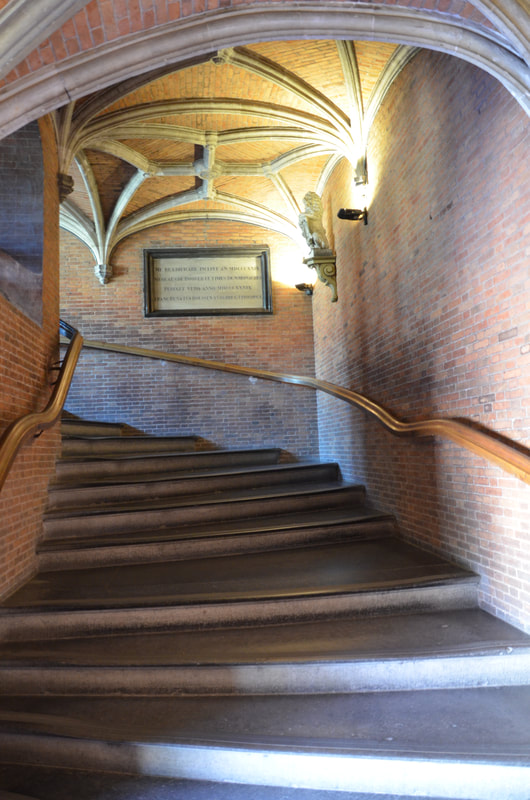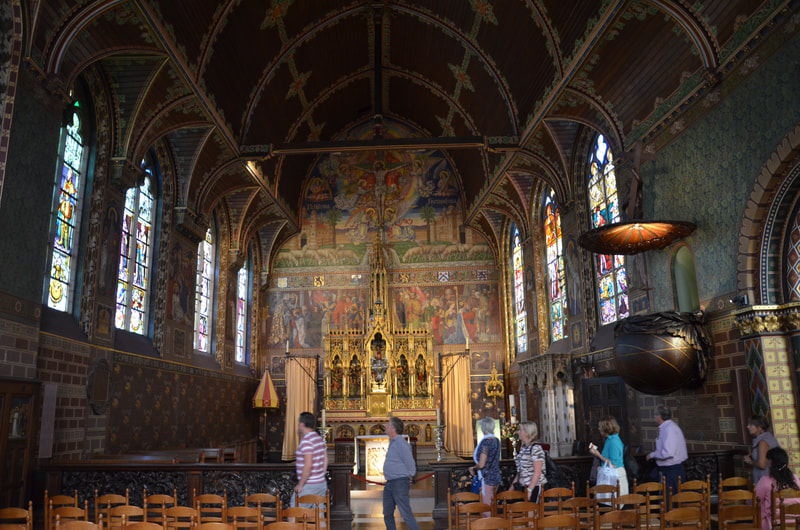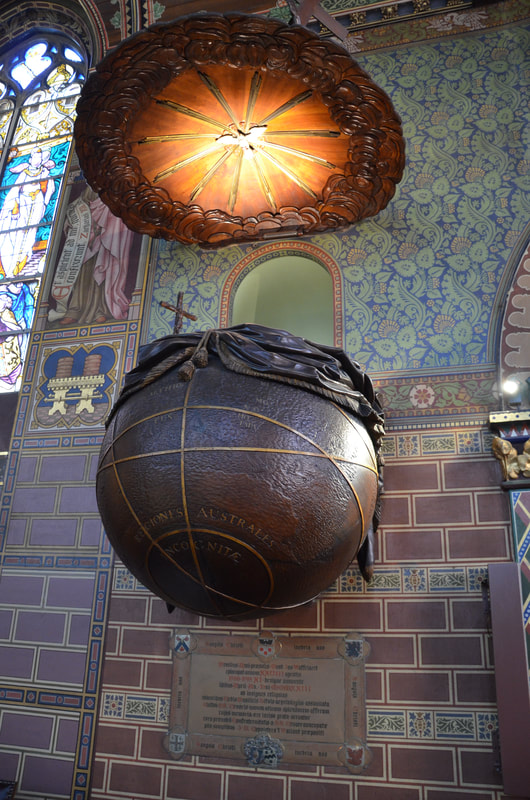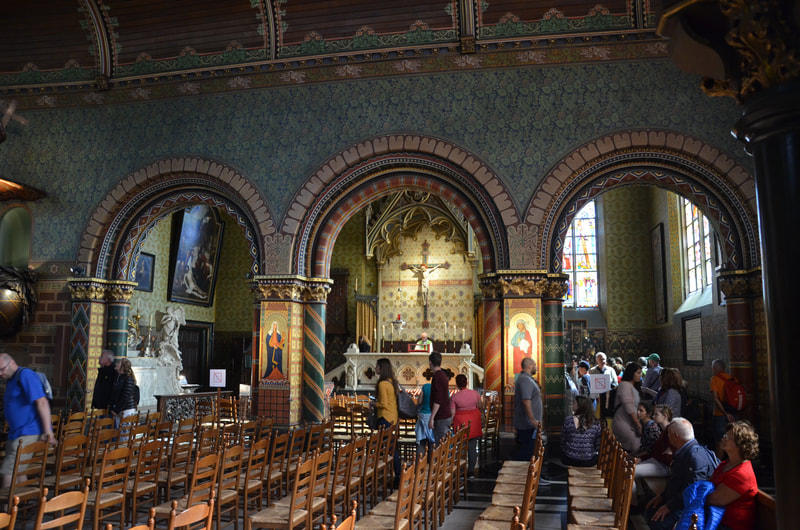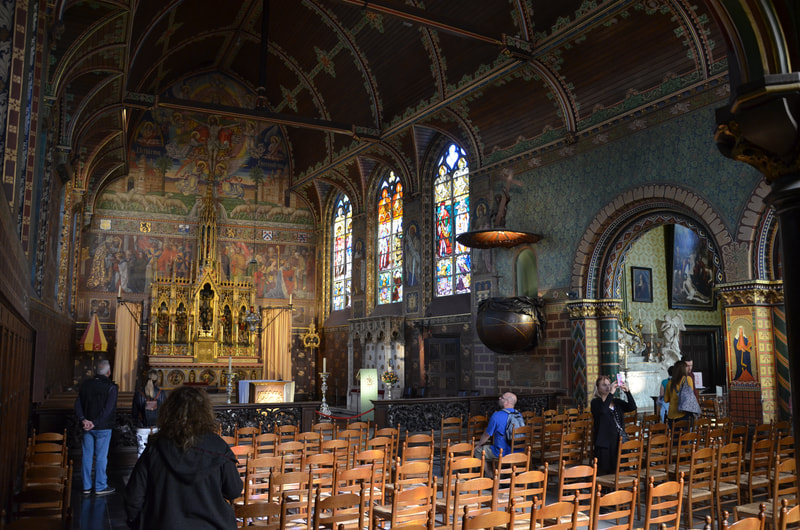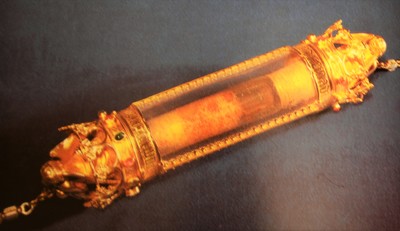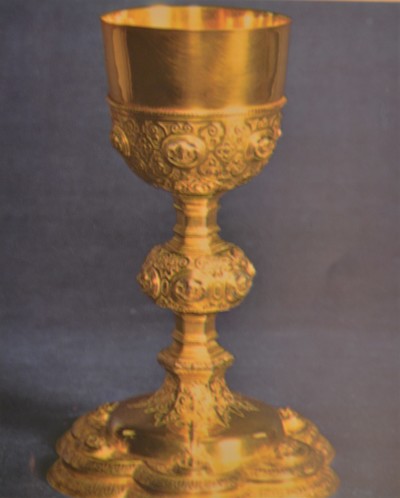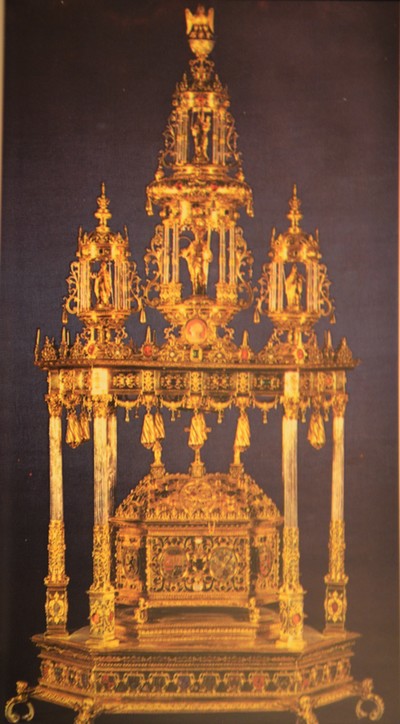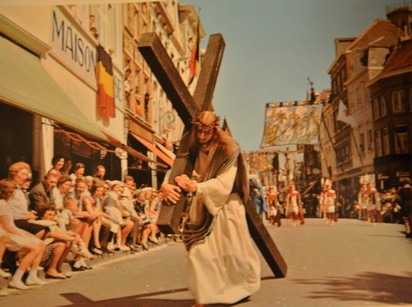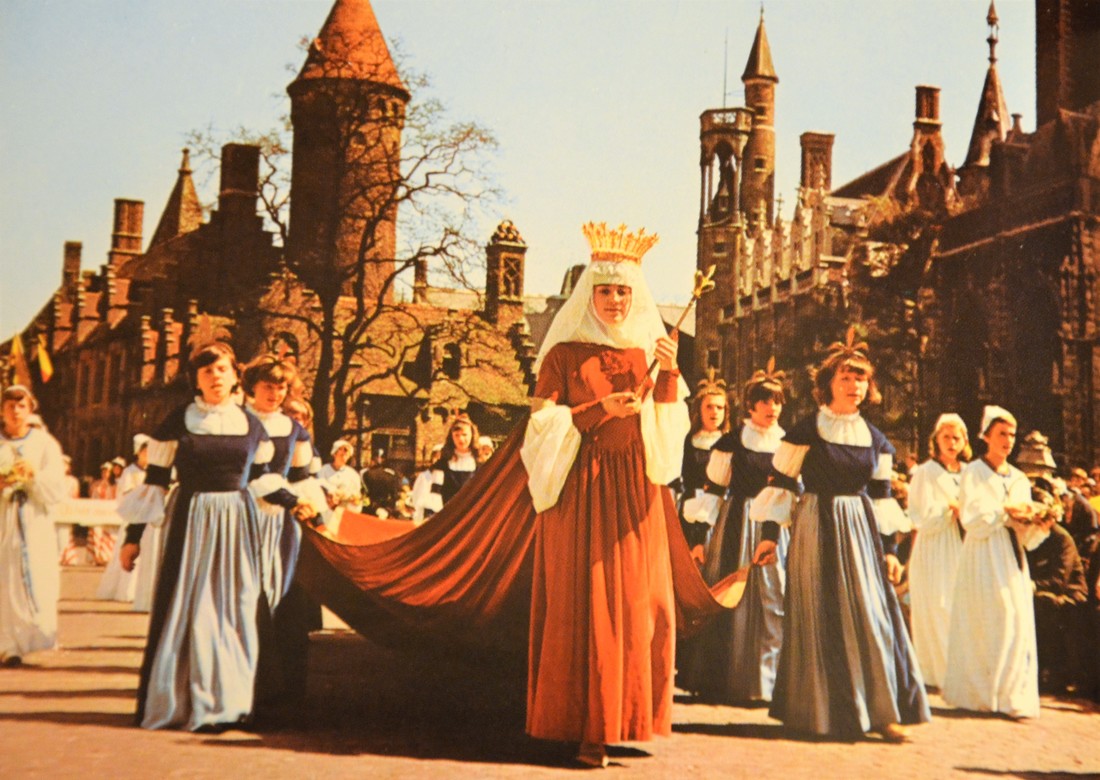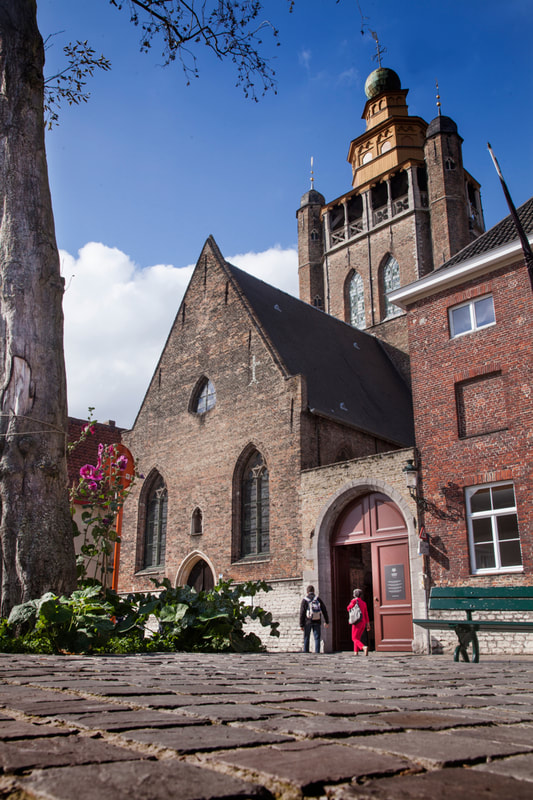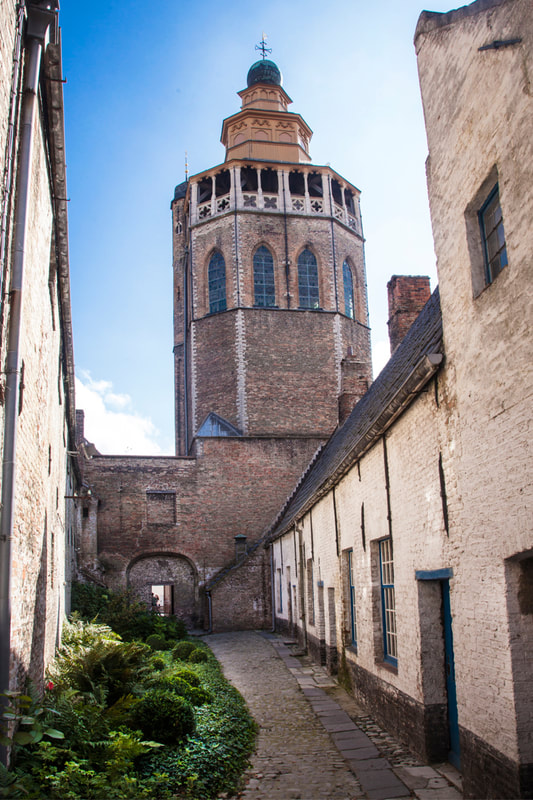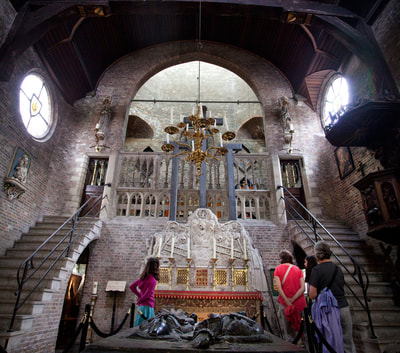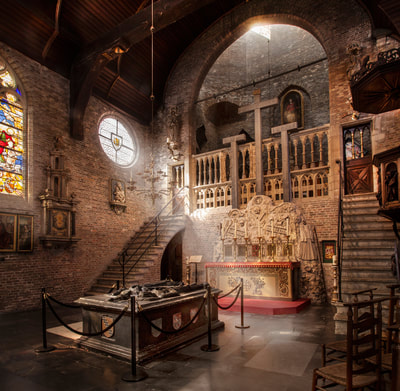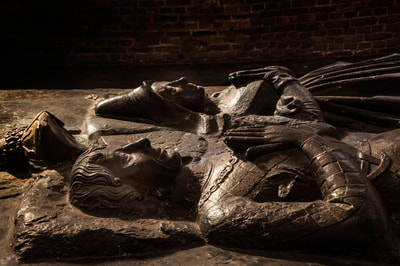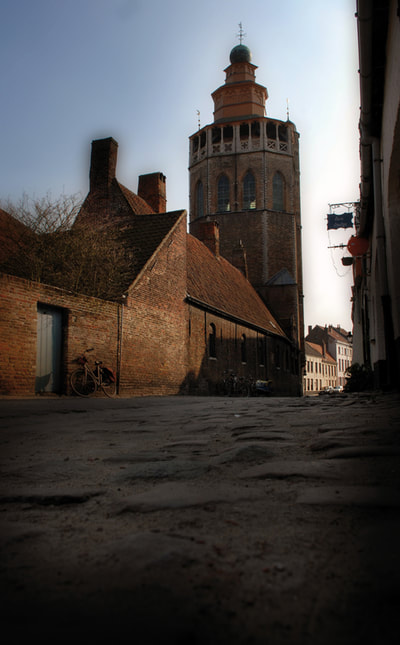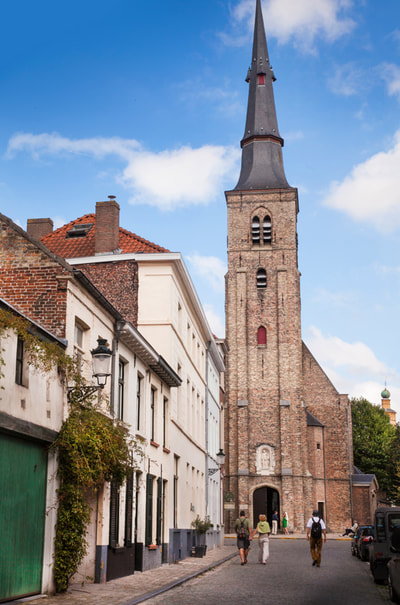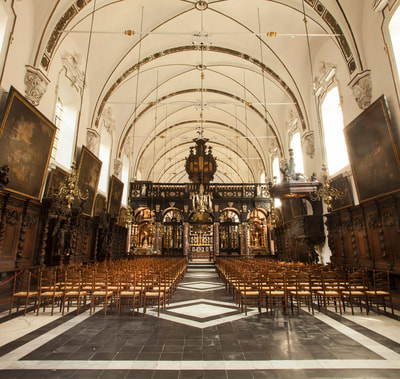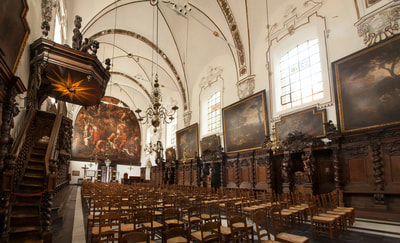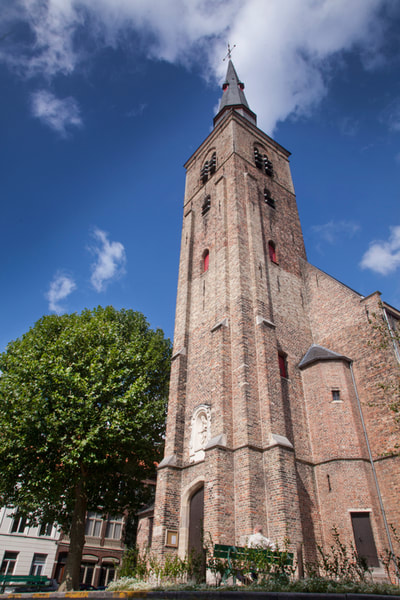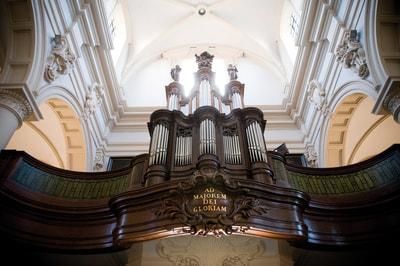Bruges' religious heritage consists of several dozen churches. Many of them are real architectural pearls. Often, however, the external appearance can be confusing. An inconspicuous church can hide a wonderful interior. The best example is the church of Saint Anna, which resembles its patron, modest outside, with a rich interior. Architecture is not the only reason to visit these churches. They often hide world class works of art. Paintings or sculptures of recognized masters around the world.
St. Salvator churchvertical divider
|
colloquially called the Church of the Savior is the oldest parish temple in Bruges. It is believed that already in 640 the year of Saint Eligius, bishop of Noyon, founded a church here. Later, it was rebuilt many times over the centuries. In the 13th century a Gothic style church was built here. Work began in 1280, and finally the construction of the temple was completed in 1350. The church survived four fires and the French Revolution spreading destruction among the churches. Ultimately, after the destruction by the French of the Saint Donatian cathedral, seat of the bishop, the status of the cathedral obtained, in the nineteenth century, the church of St. Salvator, which was lower and less impressive than the nearby church of the Virgin Mary. In addition, his roof burned in 1839.
|
Podjęto decyzję o renowacji i przebudowie. Jedną z opcji była budowa bardziej imponującej wieży. Architektem projektu został wybrany Anglik William Chantrella, który specjalizował się w neogotyckich pracach restauracyjnych. Ku zdziwieniu wszystkich Chantrella nie wybudował większej wieży w stylu neogotyckim, a stworzył projekt wieży w stylu romańskim.
Kościół św. Salwatora posiada wiele wspaniałych dzieł sztuki. Część z nich była wykonana specjalnie dla tego kościoła, resztę przeniesiono tutaj ze zniszczonej katedry św. Donacjana.
Kościół św. Salwatora posiada wiele wspaniałych dzieł sztuki. Część z nich była wykonana specjalnie dla tego kościoła, resztę przeniesiono tutaj ze zniszczonej katedry św. Donacjana.
Ten najstarszy parafialny kościół w Brugii słynie z krzyżowego chóru z organami, ze średniowiecznych grobowców, wspaniałych zbiorów sztuki flamandzkiej z XVI-XVIII wieku, oraz z pięknych gobelinów. Główny ołtarz powstał w 1642 roku i został zaprojektowany przez J. Cocxa. Statuy trzech patronów, świętych kościoła, Sauveura, Donacjana i Eligiusa stoją ponad ołtarzem. Stalle w prezbiterium pochodzą z 1430 roku.
Pulpit w kształcie orła wykonano w 1605 roku. Wspaniałe lektorium, na którego szczycie znajduje się monumentalna rzeźba z białego marmuru Bóg Ojciec zaprojektował Artus Quellin Młodszy w roku 1682. Ponad nim znajdują się XVIII-wieczne organy. Arrasy zamówione przez biskupa Van Susterena w 1731 roku zostały utkane przez Van der Borghta w Brukseli. Na ścianach wiszą oryginalne obrazy Jana van Orleya, na podstawie których powstały gobeliny (są ich lustrzanym odbiciem). Wspaniałe drzwi, będące częścią lektorium, zostały stworzone z kawałka miedzi w 1708 roku przez artystę W. Somersa.
Muzeum kościelne posiada kilka znakomitych dzieł sztuki: tryptyk Tortury św. Hippolytusa, Tryptyk Ostatnia Wieczerza P. Pourbusa (1599). Dzieła Dirka Boutsa czy Hugo van der Goesa, kilkusetletnie rękopisy, rzeźby, a także srebrne oraz złote wyroby artystyczne.
Pulpit w kształcie orła wykonano w 1605 roku. Wspaniałe lektorium, na którego szczycie znajduje się monumentalna rzeźba z białego marmuru Bóg Ojciec zaprojektował Artus Quellin Młodszy w roku 1682. Ponad nim znajdują się XVIII-wieczne organy. Arrasy zamówione przez biskupa Van Susterena w 1731 roku zostały utkane przez Van der Borghta w Brukseli. Na ścianach wiszą oryginalne obrazy Jana van Orleya, na podstawie których powstały gobeliny (są ich lustrzanym odbiciem). Wspaniałe drzwi, będące częścią lektorium, zostały stworzone z kawałka miedzi w 1708 roku przez artystę W. Somersa.
Muzeum kościelne posiada kilka znakomitych dzieł sztuki: tryptyk Tortury św. Hippolytusa, Tryptyk Ostatnia Wieczerza P. Pourbusa (1599). Dzieła Dirka Boutsa czy Hugo van der Goesa, kilkusetletnie rękopisy, rzeźby, a także srebrne oraz złote wyroby artystyczne.
|
Address:
Sint-Salvatorskoorstraat 8,
8000 Brugge, Belgia |
Opening hours:
monday-friday: 10.00-13.00 and 14.00-17.30
saturday: 10.00-13.00 and 14.00-15.30 sunday: 11.30-12.00 and 14.00-17.00 |
Church of St. Jacob został zbudowany bez nawy około 1240 roku. Dzięki dotacji od księcia Burgundii i bogatych mieszkańców Brugii rozbudowano go w XV wieku. Ten gotycki kościół został ogołocony ze wspaniałych dzieł sztuki przez ikonoklastów w 1580 roku. Jego restauracja w barokowym stylu zajęła dwa wieki. Kościół posiada bardzo harmonijne wnętrze z wieloma dziełami sztuki.
|
Address:
Sint-Jakobsplein 1,
8000 Brugge |
Opening hours:
monday-sunday
11.00-18.00 |
Holy Blood Basilica |
vertical divider
Heilig Bloed Basiliek. It took its name from the relic of the blood of Christ, which came here somewhere between 1150 and 1200. The temple consists of two separate chapels. The lower, Romanesque, comes from the 12th century and is almost devoid of decoration. The higher one, rebuilt in the Gothic style in the 15th century, has wall decorations from the last renovation carried out in the 19th century.
|
Dolna kaplica Bazyliki św. Krwi była wybudowana w XII wieku, na zlecenie hrabiego Teodora z Alzacji (1128-1168), jako dom dla relikwii Świętego Bazylego. Jest to najstarsza kaplica w mieście i do dnia dzisiejszego nosi imię tego świętego. Jest to również jedyny w zachodniej Flandrii w pełni zachowany kościół w stylu romańskim. Kaplica składa się z dwóch naw bocznych i nawy głównej, przechodzącej w prezbiterium, zakończone półokrągłą absydą. Panuje tutaj ascetyczny wystrój, który potęgują gołe kamienne ściany oraz nieliczne rzeźby.
Ponad głównym wejściem, w oryginalnym murze, znajduje się XII-wieczny tympanon, najstarsza antyczna rzeźba w Brugii. Przedstawia ona chrzest Świętego Bazylego w rzece Jordan, celebrowany, jak głosi legenda, przez Maksymiliana, biskupa Jerozolimy. W chmurach pojawia się gołąb. W prawej nawie znajduje się polichromowana, drewniana rzeźba Madonna z dzieciątkiem, datowana na początek XIV wieku.
Ecce Homo to rzeźba wykonana z drzewa sosnowego przez D'Hondta z Brugii około 1900 roku. Rzeźba ta nazywana jest potocznie Jezus na zimnym kamieniu lub Jezus na małym drewnianym cokole. Na pomalowanych kolanach rzeźby Jezusa można zobaczyć wytarte miejsca. Jest to spowodowane pocieraniem tych okolic przez wiernych.
Pieta to dzieło pochodzącego z Brugii artysty De Wispelaere. Przedstawia ona Matkę Bożą trzymającą na kolanach ciało Jezusa.
Ponad głównym wejściem, w oryginalnym murze, znajduje się XII-wieczny tympanon, najstarsza antyczna rzeźba w Brugii. Przedstawia ona chrzest Świętego Bazylego w rzece Jordan, celebrowany, jak głosi legenda, przez Maksymiliana, biskupa Jerozolimy. W chmurach pojawia się gołąb. W prawej nawie znajduje się polichromowana, drewniana rzeźba Madonna z dzieciątkiem, datowana na początek XIV wieku.
Ecce Homo to rzeźba wykonana z drzewa sosnowego przez D'Hondta z Brugii około 1900 roku. Rzeźba ta nazywana jest potocznie Jezus na zimnym kamieniu lub Jezus na małym drewnianym cokole. Na pomalowanych kolanach rzeźby Jezusa można zobaczyć wytarte miejsca. Jest to spowodowane pocieraniem tych okolic przez wiernych.
Pieta to dzieło pochodzącego z Brugii artysty De Wispelaere. Przedstawia ona Matkę Bożą trzymającą na kolanach ciało Jezusa.
Po lewej stronie prezbiterium znajduje się Kaplica Świętego Iwona (Yves). Pochodzi ona z roku 1504. Znajdują się tutaj relikwie Świętego Bazylego oraz Karola Dobrego, hrabiego Flandrii, który został zamordowany. Wykonane z czarnego marmuru tabernakulum jest dziełem Lancelota Blondeela.
Dolna kaplica jest podporą dla kaplicy górnej, która również była wybudowana w stylu romańskim, jednak na przestrzeni wieków była kilkukrotnie przebudowywana. Obie kaplice noszą tytuł Bazyliki Mniejszej.
Monumentalna Klatka schodowa De Steeghere, prowadząca do kaplicy górnej, została wybudowana w stylu renesansowym w 1533 roku. Posągi na jej zewnętrznej fasadzie wykonano zgodnie z rysunkami, które stworzył Lancelot Bloondel. Budynek ten został odbudowany w XIX wieku po zniszczeniach, jakich dokonano podczas francuskiej okupacji.
Pozłacane posągi z brązu, zdobiące fasadę klatki schodowej, przedstawiają postaci arcyksiężniczek Izabeli i Marii z Burgundii, oraz hrabiego Teodora i jego syna Filipa z Alzacji. Na medalionach widnieją arcyksiążę Albert i Maksymilian Habsburgski, Małgorzata z Yorku i Sybilla z Andegawenii, żona Teodora i matka Filipa z Alzacji.
Dolna kaplica jest podporą dla kaplicy górnej, która również była wybudowana w stylu romańskim, jednak na przestrzeni wieków była kilkukrotnie przebudowywana. Obie kaplice noszą tytuł Bazyliki Mniejszej.
Monumentalna Klatka schodowa De Steeghere, prowadząca do kaplicy górnej, została wybudowana w stylu renesansowym w 1533 roku. Posągi na jej zewnętrznej fasadzie wykonano zgodnie z rysunkami, które stworzył Lancelot Bloondel. Budynek ten został odbudowany w XIX wieku po zniszczeniach, jakich dokonano podczas francuskiej okupacji.
Pozłacane posągi z brązu, zdobiące fasadę klatki schodowej, przedstawiają postaci arcyksiężniczek Izabeli i Marii z Burgundii, oraz hrabiego Teodora i jego syna Filipa z Alzacji. Na medalionach widnieją arcyksiążę Albert i Maksymilian Habsburgski, Małgorzata z Yorku i Sybilla z Andegawenii, żona Teodora i matka Filipa z Alzacji.
The upper chapel of the Basilica of the Holy Blood was also built in the 12th century in the Romanesque style. At the end of the 15th century the chapel was rebuilt in the Gothic style. It was devastated twice (the first time in the 16th century, the second time, almost completely, in 1795 during the French Revolution). In the year 1829 it was rebuilt in so-called Neo-Gothic style. 13 April 1923 year Pope Pius XI gave both chapels the title of Minor Basilica.
Ołtarz główny używany do Eucharystii jest ozdobiony płaskorzeźbą z początku XVII wieku, przedstawiającą Ostatnią Wieczerzę. Duży obraz za ołtarzem powstał w 1905 roku. W górnej części Misterium Krzyża przedstawia konającego Jezusa, w tle dwa miasta, Betlejem, w którym się narodził, i Jerozolima gdzie zmarł. W dolnej części obrazu przedstawiono transport relikwii z krwią Chrystusa z Jerozolimy do Brugii. Po lewej stronie Teodor z Alzacji odbiera relikwię z rąk króla Jerozolimy Baldwina III, po stronie prawej, klęcząc, obok hrabiny Sybilli Andegaweńskiej, oddaje relikwię w ręce kapłana.
Ambona w kształcie globu datowana jest na 1728 rok. Jej twórcą był Henryk Pulinckx, a kształt inspirowały słowa ewangelii: „Idźcie na cały świat i głoście Ewangelię" MK16.15
Witraże w prezbiterium powstały w 1845 roku i przedstawiają postaci władające Hrabstwem Flandrii od Filipa Odważnego, księcia Burgundii (1342-1404), aż po Marię Teresę, cesarzową Austrii (1717-1780).
W kaplicy Świętego Krzyża znajduje się biały ołtarz z marmuru. Został on wykonany w stylu barokowym przez Laurenta Delvauxa w 1751 roku. Dwa anioły adoracji to dzieło Petera Pepersa. Relikwia z krwią Chrystusa przechowywana jest w pięknym srebrnym tabernakulum, stworzonym przez lokalnego złotnika Francois Ryelandta (1709-1774). Po prawej stronie ołtarza wisi wspaniały obraz pędzla Jacoba van Oosta, przedstawiający zdjęcie z krzyża.
Witraże w prezbiterium powstały w 1845 roku i przedstawiają postaci władające Hrabstwem Flandrii od Filipa Odważnego, księcia Burgundii (1342-1404), aż po Marię Teresę, cesarzową Austrii (1717-1780).
W kaplicy Świętego Krzyża znajduje się biały ołtarz z marmuru. Został on wykonany w stylu barokowym przez Laurenta Delvauxa w 1751 roku. Dwa anioły adoracji to dzieło Petera Pepersa. Relikwia z krwią Chrystusa przechowywana jest w pięknym srebrnym tabernakulum, stworzonym przez lokalnego złotnika Francois Ryelandta (1709-1774). Po prawej stronie ołtarza wisi wspaniały obraz pędzla Jacoba van Oosta, przedstawiający zdjęcie z krzyża.
Muzeum Świętej Krwi to niewielki skarbiec, w którym zgromadzono najcenniejsze skarby, świadczące o bogatej historii bazyliki i jej relikwii. Znajdziemy tutaj wspaniały relikwiarz z 1617 roku, w którym podczas procesji transportowana jest relikwia z krwią Chrystusa. Jest on dziełem złotnika z Brugii Jana Crabbe. Do stworzenia tego arcydzieła wykorzystano 30 kilogramów złota i srebra oraz ponad 100 szlachetnych kamieni. Figurki na nim umieszczone przedstawiają św. Donacjana (patrona Brugii), Matkę Boską i św. Bazylego. Relikwiarz zwieńczony jest koroną, która, jak się uważa, należała do Marii Burgundzkiej.
Oprócz tego znajduje się tutaj również szereg innych wspaniałych eksponatów, m.in.: mały srebrny relikwiarz podarowany przez arcyksiążęta Alberta i Izabelę w 1612 roku, pozłacany srebrny kielich z wyrytymi słowami Passibus Aequis 1652, który jest nadal używany w czasie ważnych ceremonii, dwa panele, namalowane w roku 1556 przez Pietera Pourbusa, przedstawiające 31 członków Bractwa Świętej Krwi, sześć medalionów wyrzeźbionych w drewnie dębowym przez Henryka Pulinckxa w 1728 roku, przedstawiających kilka scen z życia Chrystusa: obrzezanie, chłostę, koronę cierniową, zdjęcie z krzyża, złożenie do grobu, zmartwychwstanie.
Oprócz tego znajduje się tutaj również szereg innych wspaniałych eksponatów, m.in.: mały srebrny relikwiarz podarowany przez arcyksiążęta Alberta i Izabelę w 1612 roku, pozłacany srebrny kielich z wyrytymi słowami Passibus Aequis 1652, który jest nadal używany w czasie ważnych ceremonii, dwa panele, namalowane w roku 1556 przez Pietera Pourbusa, przedstawiające 31 członków Bractwa Świętej Krwi, sześć medalionów wyrzeźbionych w drewnie dębowym przez Henryka Pulinckxa w 1728 roku, przedstawiających kilka scen z życia Chrystusa: obrzezanie, chłostę, koronę cierniową, zdjęcie z krzyża, złożenie do grobu, zmartwychwstanie.
|
Address:
Burg 13,
8000 Brugge |
Opening hours:
monday-sunday:
9.30-12.30 and 14.00-17.30 |
Ticket price:
Church: for free
Treasury: 2,5 Euro |
Holy Blood procession
Najstarsza wzmianka o procesji pochodzi ze statutu Unloaders'Guild z 1291 roku. Dowiadujemy się z niego, że urzędnicy miejscy byli zobligowani do uczestnictwa w procesji. Prawdopodobnie relikwia Świętej Krwi była eksponowana w kaplicy na placu Burg już przed 1291 rokiem. Od 1303 roku procesja poruszała się wokół murów miejskich. Stała się wielkim wydarzeniem, w którym uczestniczyli mieszkańcy, radni miejscy i naturalnie duchowieństwo.
W roku 1310 Papież Klemens V wydał bullę, w której nadawał absolutorium na pięć lat i 200 dni grzesznikom uczestniczącym pobożnie w procesji, lub odwiedzającym bazylikę w ciągu 14 dni od przejścia procesji.
W XV i XVI wieku, obok tradycyjnych scen biblijnych, zaczęto odgrywać scenki świeckie m.in. z udziałem figur olbrzymów.
Ze względu na zagrożenie, jakie niósł za sobą wzrost napięć na tle religijnym, w 1578 roku zrezygnowano z prowadzenia procesji wokół murów miejskich. Procesja kroczyła centrum miasta, i tak pozostało po dzień dzisiejszy.
W latach 1578-1584 w Brugii panował system kalwiński. Zakazano organizowania procesji, a ze względów bezpieczeństwa relikwię ukryto. W czasie kontrrewolucji w XVII wieku, a także w XVIII wieku procesja odzyskała swój religijny charakter. Ponownie zakazano jej organizowania za czasów panowania Francuzów (1798-1819).
W XIX wieku wznowiono ponownie procesję Świętej Krwi. Do 1969 roku odbywała się ona rankiem w pierwszy poniedziałek po 2 maja. W roku 1970 zmieniono datę procesji. Aż do dnia dzisiejszego odbywa się ona w dniu Święta Wniebowstąpienia (w 40 dniu od Zmartwychwstania Pańskiego), który jest w Belgii dniem wolnym od pracy. W procesji ulicami miasta czynnie bierze udział około 1800 uczestników. Przyciąga ona rokrocznie około 50 tysięcy pielgrzymów.
W roku 1310 Papież Klemens V wydał bullę, w której nadawał absolutorium na pięć lat i 200 dni grzesznikom uczestniczącym pobożnie w procesji, lub odwiedzającym bazylikę w ciągu 14 dni od przejścia procesji.
W XV i XVI wieku, obok tradycyjnych scen biblijnych, zaczęto odgrywać scenki świeckie m.in. z udziałem figur olbrzymów.
Ze względu na zagrożenie, jakie niósł za sobą wzrost napięć na tle religijnym, w 1578 roku zrezygnowano z prowadzenia procesji wokół murów miejskich. Procesja kroczyła centrum miasta, i tak pozostało po dzień dzisiejszy.
W latach 1578-1584 w Brugii panował system kalwiński. Zakazano organizowania procesji, a ze względów bezpieczeństwa relikwię ukryto. W czasie kontrrewolucji w XVII wieku, a także w XVIII wieku procesja odzyskała swój religijny charakter. Ponownie zakazano jej organizowania za czasów panowania Francuzów (1798-1819).
W XIX wieku wznowiono ponownie procesję Świętej Krwi. Do 1969 roku odbywała się ona rankiem w pierwszy poniedziałek po 2 maja. W roku 1970 zmieniono datę procesji. Aż do dnia dzisiejszego odbywa się ona w dniu Święta Wniebowstąpienia (w 40 dniu od Zmartwychwstania Pańskiego), który jest w Belgii dniem wolnym od pracy. W procesji ulicami miasta czynnie bierze udział około 1800 uczestników. Przyciąga ona rokrocznie około 50 tysięcy pielgrzymów.
Chapel of Jerusalem
Outside the beaten Bruges tourist trail, there is a very interesting Jerusalemkapel. Built by the family of Italian merchants Adornes, the chapel is one of the most enigmatic places of worship in Bruges. Also called the Church of the Holy Tomb, the chapel is in private hands to this day. The first member of the Adornes family settled in Bruges was Oppicino from Genoa, who died in 1307 a year. For centuries, the family has grown richer and gained importance. Finally, they decided to build a new chapel. 12 May 1427, the Pope gave permission to build the temple.
Kaplica Jeruzalem oraz dom rodziny Adornes stanowią część kompleksu wybudowanego przez rodzinę bogatych kupców. Oba budynki połączone są galerią. Budowę kaplicy rozpoczęto w 1470 roku, po powrocie z pielgrzymki do Jerozolimy Anzelma Adornesa i jego syna.
Kościół składa się z nawy głównej, w której znajduje się grobowiec. Za mauzoleum umieszczono ołtarz główny, zwieńczony trzema wielkimi krzyżami, reprezentującymi Golgotę. Przedstawia on czaszki, ponieważ Golgota tłumaczona jest jako miejsce czaszki. Poza ołtarzem znajduje się krypta prowadząca do miejsca symbolizującego Grób Święty, w którym złożono ciało Chrystusa. Jest to cecha bardzo rzadka we Flandrii, popularna natomiast w krajach śródziemnomorskich. Jest to również, jak się przypuszcza, powód, dla którego kaplica nosi nazwę Jeruzalem. Strome schody po prawej i lewej stronie prowadzą do prezbiterium usytuowanego na półpiętrze. Ta część odseparowana jest od reszty kaplicy za pomocą dwóch małych dębowych drzwi, które datowane są na 1484 rok.
Takie dwupoziomowe kaplice były dość popularne w średniowieczu, czego dowodem jest kaplica Świętej Krwi w centrum miasta. Na pięknych witrażach przedstawiono członków rodziny Adornes, wspieranych przez ich świętych patronów. Na ścianach wiszą dwa wspaniałe XV-wieczne tryptyki: Madonna ze Świętą Katarzyną i Świętą Barbarą, oraz Chrystus na krzyżu. Nad kaplicą dominuje ośmiokątna wieża, zwieńczona krzyżem Jeruzalem.
Kościół składa się z nawy głównej, w której znajduje się grobowiec. Za mauzoleum umieszczono ołtarz główny, zwieńczony trzema wielkimi krzyżami, reprezentującymi Golgotę. Przedstawia on czaszki, ponieważ Golgota tłumaczona jest jako miejsce czaszki. Poza ołtarzem znajduje się krypta prowadząca do miejsca symbolizującego Grób Święty, w którym złożono ciało Chrystusa. Jest to cecha bardzo rzadka we Flandrii, popularna natomiast w krajach śródziemnomorskich. Jest to również, jak się przypuszcza, powód, dla którego kaplica nosi nazwę Jeruzalem. Strome schody po prawej i lewej stronie prowadzą do prezbiterium usytuowanego na półpiętrze. Ta część odseparowana jest od reszty kaplicy za pomocą dwóch małych dębowych drzwi, które datowane są na 1484 rok.
Takie dwupoziomowe kaplice były dość popularne w średniowieczu, czego dowodem jest kaplica Świętej Krwi w centrum miasta. Na pięknych witrażach przedstawiono członków rodziny Adornes, wspieranych przez ich świętych patronów. Na ścianach wiszą dwa wspaniałe XV-wieczne tryptyki: Madonna ze Świętą Katarzyną i Świętą Barbarą, oraz Chrystus na krzyżu. Nad kaplicą dominuje ośmiokątna wieża, zwieńczona krzyżem Jeruzalem.
|
Address:
Peperstraat 1,
8000 Brugge |
Opening hours:
monday-saturday: 10.00-17.00
sunday: closed |
Ticket price:
7 Euro
|
Kościół św. Anny wybudowano w 1621 roku, a konsekrowano w roku 1624. Zastąpił on dawny gotycki kościół, który został zburzony w 1581 roku. Z zewnątrz nie zachwyca, nie ujawnia wspaniałego wnętrza. Spacerując uliczkami Brugii można nie zwrócić na niego uwagi. Jednak Sint Annakerk, bo tak brzmi jego flamandzka nazwa, zaskakuje wspaniałym barokowym wnętrzem, jednym z najpiękniejszych wśród kościołów Brugii.
Kościół przypomina jego patronkę, na zewnątrz skromny, z bogatym wnętrzem. Charakteryzuje go prosta salowa budowa. Zgromadzono tutaj wiele wspaniałych dzieł sztuki.
W kościele można podziwiać: piękne marmurowe lektorium, które stworzył H. van Mildert (1626-1628), pochodzącą z XV wieku rzeźbę św. Anny, wspaniałe dębowe panele, w które wbudowano konfesjonały. Duże obrazy we frontowej części kościoła, przedstawiające sceny z życia Świętej Anny i Świętej Marii, namalował Jan Garemijn.
Kościół przypomina jego patronkę, na zewnątrz skromny, z bogatym wnętrzem. Charakteryzuje go prosta salowa budowa. Zgromadzono tutaj wiele wspaniałych dzieł sztuki.
W kościele można podziwiać: piękne marmurowe lektorium, które stworzył H. van Mildert (1626-1628), pochodzącą z XV wieku rzeźbę św. Anny, wspaniałe dębowe panele, w które wbudowano konfesjonały. Duże obrazy we frontowej części kościoła, przedstawiające sceny z życia Świętej Anny i Świętej Marii, namalował Jan Garemijn.
The attention of visitors is also attracted by wonderful chandeliers in which candles are lit only for important occasions. Above the entrance door is a huge painting, occupying about 100 square meters. Nedrik Herregouts painted this painting in 1685 a year. It presents the Last Judgment and was to remind the faithful after leaving the church that they had to keep their promises, which they made during the prayer. The greatest Flemish poet from Bruges, Guido Gezelle, was baptized in this church.
|
Address:
Sint-Annaplein, Brugge
|
Opening hours:
monday-sunday:
11.00-18.00
|
Ticket price:
For free
|
Saint Walburga church
Świątynia, która powstawała w latach 1619-1642, w stylu barokowym, jest dziełem urodzonego w Brugii P. Huyssensa (1577-1637) z zakonu jezuitów. Oryginalnie kościół miał należeć do tego zakonu i miał być poświęcony Świętemu Franciszkowi Ksaweremu, którego rzeźba znajduje się w niszy nad wejściem. W czasie Rewolucji Francuskiej kościół był dekonsekrowany i poświęcony rozumowi. W 1802 roku został ponownie konsekrowany. Wewnątrz barokowy charakter wzmacniają gzymsy, woluty, pilastry oraz kolumny, które tworzą efekty świetlne.
Podłoga prezbiterium ma wzory geometryczne. Uważa się, że reprezentują one antyczny arabski język zwany pismem kufickim.
W kościele znajduje się kolekcja obrazów. Czternaście z nich znajdziemy w prezbiterium, w nawie, oraz ponad organami.
W kościele znajduje się kolekcja obrazów. Czternaście z nich znajdziemy w prezbiterium, w nawie, oraz ponad organami.
Kościół posiada marmurowy ołtarz stworzony przez Jacoba Cocxa (1643), z figurą świętej Walburgii, która jest dziełem Houvenaegela (1842). Obraz Zmartwychwstanie, będący częścią ołtarza głównego, namalował J. Suvee (1783).
Nad portalami umieszczono popiersia św. Franciszka Ksawerego i św. Franciszka Borgii, oraz posągi św. Alojzego Gonzagi i św. Stanisława Kostki.
Wspaniałą ambonę stworzył Artus Quellin Młodszy (1667-1669). Oba ołtarze boczne są dziełem Pietera Verbrugghena. Ten po stronie północnej, który powstał w 1657 roku, posiada dwa portale z figurami Świętych. Ołtarz po stronie południowej (1669) ma drzwi dębowe i posągi Piotra, Pawła i Świętego Rocha.
Nad portalami umieszczono popiersia św. Franciszka Ksawerego i św. Franciszka Borgii, oraz posągi św. Alojzego Gonzagi i św. Stanisława Kostki.
Wspaniałą ambonę stworzył Artus Quellin Młodszy (1667-1669). Oba ołtarze boczne są dziełem Pietera Verbrugghena. Ten po stronie północnej, który powstał w 1657 roku, posiada dwa portale z figurami Świętych. Ołtarz po stronie południowej (1669) ma drzwi dębowe i posągi Piotra, Pawła i Świętego Rocha.
|
Address:
Sint-Maartensplein, Brugge
|
Opening hours:
monday-sunday:
11.00-18.00
|
Ticket price:
For free
|
